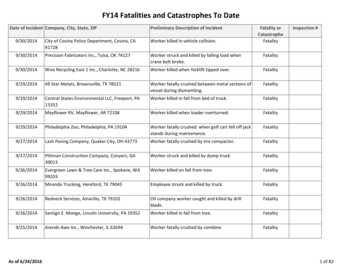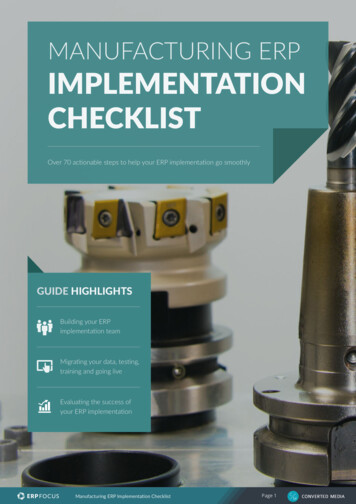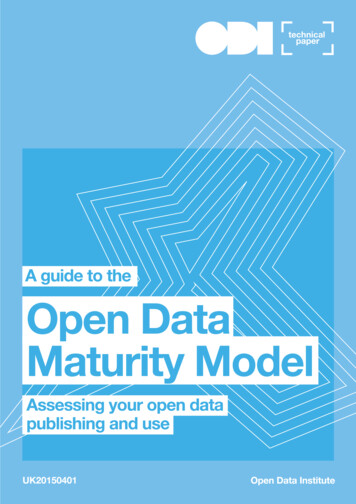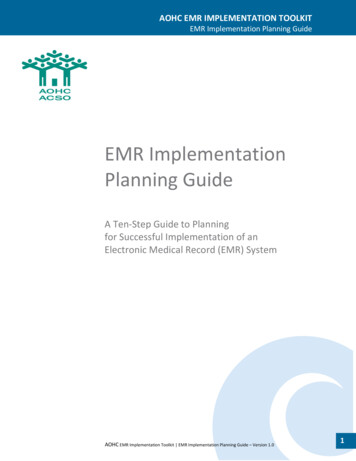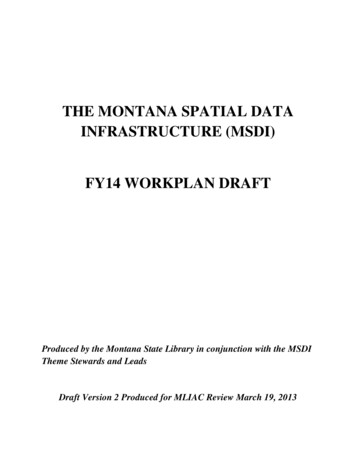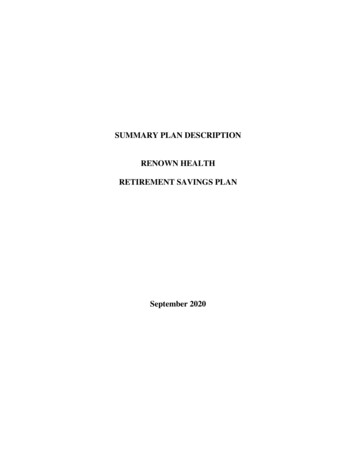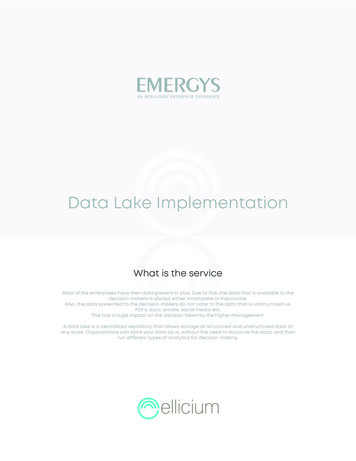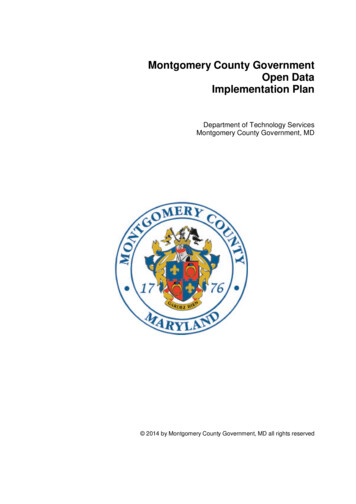
Transcription
Montgomery County GovernmentOpen DataImplementation PlanDepartment of Technology ServicesMontgomery County Government, MD 2014 by Montgomery County Government, MD all rights reserved
VERSION1.0DATE8/1/2014DESCRIPTIONInitial ReleasePage: 2AUTHORDepartment of Technology Services,Montgomery County Government
Table of ContentsMessage from the County Executive.41.0Introduction.51.1About dataMontgomery .51.2Scope .52.0Policy Requirements.62.1The Montgomery County Open Data Act .62.2County Executive Policy .63.0Governance and Business Process.73.1Open Data Program Governance and Staffing.73.2Dataset Inventory Process.73.3Establishing the Publishing Priority for Datasets .93.4Revisions to Datasets and Priority Groupings .103.5Policy for Dataset Changes or Removal .113.6Data Privacy .123.7dataMontgomery Website Availability and Bandwidth.124.0Dataset Inventory and Publishing Schedule.134.1dataMontgomery Current State (through FY14).134.1.1Published Datasets .134.2dataMontgomery FY15 Work Plan .154.2.1Datasets Scheduled for Publication in FY15 .164.2.2Open Data Initiative – dataMontgomery Taxonomy.184.2.3Open Data Initiative – Budget Book Electronic Publication.194.2.4Open Data Initiative – Financial Transparency.204.2.5Open Data Initiative – CountyStat Performance Dashboard.204.3dataMontgomery Inventory for FY16 and Beyond.215.0Maryland Public Information Act (MPIA) Requests .38Appendix A – openMontgomery Memorandum from CAO.39Appendix B – Dataset Scoring Methodology and Outreach .41Appendix C – Dataset Prioritization Count (by Department).43Appendix D – MPIA Response Publishing.44Page: 3
Message from the County ExecutiveAs County Executive I have made transparency one of my priorities and continually soughtways to keep residents better informed. In response to the Montgomery County Open Data Act,we have laid the groundwork for implementing a successful open data program by: creating anopen data website called dataMontgomery, which launched in December 2012; and leading acollaborative effort across county government and with residents to determine our open datapriorities. All of these efforts have resulted in an inventory and plan that puts MontgomeryCounty on the forefront of the open data movement.Our plan utilizes a precedent-setting method to inventory, prioritize and responsibly publishdatasets that is already becoming a model for other jurisdictions. This plan includes annualupdates, a taxonomy project, providing a user-friendly framework to assist with easily findingdatasets, and an outlook for future years. Our open data program also includes groundbreakinginitiatives such as: An electronic budget book applicationAn interactive, data-driven dashboard of the County’s performance metricsA financial transparency suite, which will provide resident driven view of our financesand budgetA website that publishes Maryland Public Information Act responsesThis plan is only the beginning. We’ve taken the lead as a transparent and responsivegovernment and have not let up. From local civic groups to national policy organizations like theSunlight Foundation, we are setting the tone for transparency not only in Maryland but acrossthe country.Ike Leggett, County ExecutivePage: 4
1.0 Introduction1.1About dataMontgomeryA responsive and accountable County Government has long been among the County’s highestpriorities. On December 5, 2012, County Executive Isiah Leggett announced the“openMontgomery” initiative. This announcement was in concert with the Open Data Bill 23-12introduced by Councilmember Hans Riemer. The full Council approved Bill 23-12 on December4, 2012, and thereby enacted what is now the Montgomery County Open Data Act (seeMontgomery County Code §§ 2-152 – 159), with an effective date of March 18, 2013. Togetherthese actions launched the dataMontgomery website as the County’s comprehensive singlesource of data supporting a path to even greater transparency, accessibility and efficiency in thefuture.The dataMontgomery program seeks to provide residents and constituents with direct access toCounty datasets in consumable formats, so they may be viewed, sorted and used in variousways, including being potentially leveraged in the development of new applications and servicesby interested parties. Providing this information offers the public an opportunity to review andanalyze raw data, and the opportunity to use it for a variety of purposes.Link to the openMontgomery web portal: http://www.montgomerycountymd.gov/open/Link to the dataMontgomery website: mery County has already made available many high value datasets though thedataMontgomery website (https://data.montgomerycountymd.gov/). The Montgomery CountyGovernment Open Data Implementation Plan will document the additional County datasets thatare not yet available on the dataMontgomery website, but which will be published in the future.This Implementation Plan is available on Montgomery County’s openMontgomery web portal(http://www.montgomerycountymd.gov/open/) and will be updated no later than July 15, 2015,and every July 15th thereafter.This Implementation Plan has been prepared in compliance with the Open Data Act. TheImplementation Plan is intended to be a comprehensive inventory of the public datasetsmaintained by the Montgomery County Government as well as a commitment to make thesedatasets publicly available by the publication dates specified in this document. ThisImplementation Plan is a living document and will be updated annually as additional datasetsare identified and released in compliance with the Open Data Act.The scope of this document covers the implementation process for publishing datasets. Theimplementation process is the governance, business processes around indentifying the datasetsin each department that are planned for publication and the list of candidate datasets forpublication. For information on technical publishing standards, please refer to the MontgomeryCounty Government Technical Standards Manual for Publishing a Public Data ards.pdf).Page: 5
2.0 Policy Requirements2.1The Montgomery County Open Data ActThe Montgomery County Open Data Act, codified in Sections 2-152 – 2-159 of the MontgomeryCounty Code, sets a number of requirements for an Open Data Implementation Plan. Asdetailed in Montgomery County Code Section 2-158(a), the plan must: Include a summary description of a public data set under the control of each agency onor after the bill took effect;Prioritize the public data sets for inclusion on the single web portal on or beforeDecember 31, 2018, under the standards adopted by the County; andCreate a timeline for the inclusion on the single web portal.If a public data set cannot be made available on the single web portal on or before December31, 2018, this Plan must state the reason why the data set cannot be made available, and, tothe extent practicable, the date by which the agency in possession of the public data setbelieves that it will be available on the single web portal. See Montgomery County Code § 2158(b).Within 18 months after the Open Data Act took effect on March 13, 2013, the ChiefAdministrative Officer must issue to the Executive and Council, via Method (2) regulation, thisOpen Data Implementation Plan. See Montgomery County Code § 2-158(a). Subsequently, theOpen Data Implementation Plan must be updated annually by July 15, 2015 and every July 15thereafter until all public data sets to be published have been made available through a singleweb portal. See Montgomery County Code § 2-158(c).Additionally, the Open Data Act also has a provision that covers Public Information ActResponses. See Montgomery County Code § 2-159. The provision requires this Open DataImplementation Plan to document which data elements are to be made available on the webportal for each Maryland Public Information Act request and a schedule for implementation.2.2County Executive PolicyOne of the key initiatives of the current administration is to support an open government. This isembodied in one of the provisions of the County Executive’s Mission Statement - “A Responsiveand Accountable County Government”. The dataMontgomery program is a continuation of thatpolicy that is fully supported by the administration. On December 4, 2012, the ChiefAdministrative Officer officially kicked off the initial survey of government datasets for all Countydepartments (see Appendix A) in conjunction with the initial rollout of the dataMontgomerywebsite. Finally, the ongoing governance and project implementation has the support andguidance of the Chief Administrative Officer with an Assistant CAO chairing thedataMontgomery Steering Committee.Page: 6
3.0 Governance and Business Process3.1Open Data Program Governance and StaffingMontgomery County’s Department of Technology Services (DTS) has established a multilayered governance process for the Open Data project. The governance process used for thisproject leverages the governance processes as defined in the County’s Enterprise TechnologyIT Strategic Plan, Section 6: Governance, which can be viewed on-line on the MontgomeryCounty Government website under the Department of Technology – Strategic es/files/ETSP6.pdf).The Open Data Steering Committee is chaired by an Assistant Chief Administrative Officer andconsists of the Director of the Department of Technology Services, the Director of the PublicInformation Office; the County’s Chief Innovation Officer (CInO); the CountyStat Manager; and aliaison from the Office of the County Attorney. Generally, the Steering Committee meets on aquarterly basis to review overall policy objectives and issues related to the County’s Open Dataprogram.The Open Data Workgroup is chaired by the DTS’s Open Data Project Manager and consists ofrepresentatives from the Department of Technology Services, the Public Information Office, theMontgomery County Police Department, the County’s Innovation Program and CountyStat.Generally, the Workgroup meets on a bi-monthly basis to review tactical issues with theCounty’s Open Data program, including dataset identification, prioritization and publication.DTS has formed a matrixed Open Data Project Team tasked with overseeing the execution ofthe Open Data Implementation Plan. The DTS team consists of an Open Data ProgramManager, an Open Data Project Manager, project management staff from DTS ProjectManagement Office and technical staff from the DTS Enterprise Service Bus Team. The ProjectManager and project management staff generally work with the County’s Departments andAgencies to identify and prepare datasets for publication. The technical staff works withDepartments to develop the programs to automate, wherever possible, the publication of theDepartmental datasets onto dataMontgomery. The Open Data Project Team is staffed at a levelto support the publication of new datasets and development of new Open Data Initiatives, asdetailed in Section 4 of this document, as well as the ongoing operations of thedataMontgomery website.Additionally, each County department has a Point of Contact (POC) who represents theirdepartment in the process of indentifying, documenting and eventually publishing the data fromtheir department. All of the POCs have access to training and education on open data topicsand have become the leaders in their departments for this open data initiative. Please refer tothe next section of this document for more information on the data inventory process and thePOC’s vital role in support of this effort.3.2Dataset Inventory ProcessMontgomery County has 28 Executive Branch departments, offices and agencies, whichcollectively employ more than 600 applications, databases, and spreadsheets from which “data”may be derived. Early efforts to collect datasets for inclusion on the open data platformPage: 7
included surveying departments on what they considered to be high value data, and researchingwhat information was requested most often by residents and the press via formal MarylandPublic Information Act (MPIA) requests.However, in order to comply with the Open Data Act’s requirement for a full inventory ofgovernment data, Montgomery County needed to develop a systematic approach to identify,inventory, prioritize and queue up datasets for publication.Each County Department was asked to identify a Point of Contact (POC) with whom thedataMontgomery Workgroup would interface. One POC was identified per Department, andassigned the responsibility of compiling the dataset inventory for their Department. The teaminvested in each POC, educating them on open data concepts, joint data sharing andsensitive/confidential data awareness through webinars and office hours. POCs could be eithertechnical or business people who own the data being proposed for publication. Monthlymeetings were held with all POCs to review expectations, answer questions, demonstrate thevalue of open data, and educate them on different aspects of confidential and sensitive data.Once the POCs were established, a team was put together to assist them with their inventoryingefforts. This team was comprised of CountyStat performance experts, the dataMontgomeryproject manager, a dataMontgomery project lead and the Chief Innovation Officer.CountyStat hosted individual brainstorming sessions with each department, and sometimesindividual divisions within larger departments, to draw out a list of dataset candidates. POCswere encouraged to bring others from their department (if technical, bring a business person,and vice versa). These brainstorming sessions used the following as jump-off points fordiscussion: the department’s website (the core mission of the department plus any reports orinformation posted there); the department’s annual performance plan document that lists itsHeadline Performance Measures and other data; any existing inventory of systems,applications, databases, etc.; the existing dataMontgomery web portal; and the open data webportals of other governments. The outputs of these brainstorming sessions were captured andfed back to departments to stimulate further data exploration within their department.To facilitate the collection of dataset candidates, DTS created an online intake form fordepartments to submit the dataset candidates developed based on the brainstorming sessionsand subsequent internal work. Initially, this form yielded over 300 dataset submissions. A GapAnalysis was performed comparing submissions with department core function, systems, andperformance measures. After being notified of the Gap Analysis and follow-up meetings withteam members, departments submitted additional datasets. To date, over 500 datasets weresubmitted for consideration.At the same time as this internal view of data inventory was occurring, Montgomery County alsolooked externally to our residents. Community outreach events were conducted whereresidents could engage in conversations with County staff regarding the datasets that interestedthem and the potential ways they could put the data to use. In promoting these Town Hallevents, presentations were made at many high schools to help engage youth in the process.The feedback from these town halls was captured and reported out in the County’s InnovationProgram blog as well as Twitter. Also, some subject matter-specific workshops were held ontopics such as public safety and transit. For example, multiple Neighborhood Watch groups andrepresentatives from the Montgomery County Police Department (MCPD) met to discuss crimedata priorities. This feedback was captured and made part of the prioritization process.The Dataset Inventory Process and timeline is summarized in the table below.Page: 8
3.3Establishing the Publishing Priority for DatasetsOnce all of the dataset candidates were collected and the outreach events were held, thedatasets were subjected to a quantitative prioritization process. The goal of the prioritizationprocess was to assign each dataset a “score” representing their value relative to each other.Every dataset’s value was independently rated on twelve criteria, six “internal” and six“external,” by CountyStat and the Chief Innovation Officer. Those criteria were: Internal:Is the dataset aligned with the department’s core function / Degree to which publishingthis data furthers the core mission of the department?Is the dataset a direct or indirect source of a department’s Headline PerformanceMeasure(s) and/or Supporting Measure(s)?Will posting the data result in administrative time saved for a department(s)? (i.e. willthey be able to stop spending time responding to requests for this particularinformation?)Is the data already collected and readily accessible so as not to require new or additionalbusiness processes?Is the data used across departments and does its publication facilitate collaboration?Will publishing this dataset enable the retirement of a legacy system or database?Page: 9
External:Is the data typically used when deciding policies that impact residents’ quality of life?Will publishing this dataset allow a business or resident to perform a process moreefficiently and/or effectively?Is Montgomery County the only source of the data?Does the data contribute to civic engagement?Does the data create economic opportunity?Will publishing this dataset make the department more accountable and/or responsiveby improving/increasing the public's knowledge of its operation?For additional information on the scoring values for prioritizing the datasets, the scoringmethodology used and outreach efforts related to prioritizing the datasets, please refer toAppendix B of this document.The result is a list that ranks the datasets in a manner that allows the CAO to manage theinventory pipeline and get the highest value datasets published first. After scoring and rankingthe data sets, Montgomery County feels that this approach was effective in creating a wellbalanced pipeline that reflects the priorities of the government and the community.Please note that there are number of factors that affect the priority ranking of a dataset. Whilethe value to residents is certainly a very significant factor in forming the priority ranking of adataset, there are other internal factors which also affect the ranking. For example, datasetsthat improve the internal efficiency and communication within the government may rank higher.Each dataset has been assigned a numerical score ranging from 0 to 100. Based on thisnumerical score, the County has established the following 5 priority groupings: Group P1: Datasets ranked 80 and aboveGroup P2: Datasets ranked 70 – 79Group P3: Datasets ranked 60 – 69Group P4: Datasets ranked 50 – 59Group P5: Datasets ranked 49 or lowerThe priority groups will be used as a guideline in scheduling datasets for publication. As ageneral rule, the datasets with higher rankings will be scheduled for publication before datasetswith lower rankings. However, there are certain factors which may lead to slight deviations inscheduling by priority groups. For example, if a highly ranked dataset resides on a sourcesystem scheduled for imminent replacement, publication of that dataset would likely be delayeduntil the new system comes online to avoid “rework” in developing interfaces for publication. Inanother example, if in the process of publishing of a highly ranked dataset it is discovered thatthe required interfaces could also be easily leveraged to publish a companion lower rankeddataset, then the decision will like be made to publish both datasets at the same time forefficiency.3.4Revisions to Datasets and Priority GroupingsThe list of datasets scheduled for publication on dataMontgomery is not a static list. As new ITsystems come online, the data contained in these systems will be inventoried and prioritized forpublication on dataMontgomery.Page: 10
The priority rankings for a dataset may also change over time. A dataset with a certain priorityranking today may be repriotized with a new priority ranking based on changes to any of theinternal or external factors identified in Section 3.3, such as: A department may define a new headline measure that includes the datasetA department identifies cost savings or improved efficiency gained from publication ofthe datasetA dataset used by only one department becomes valuable to multiple departmentsCitizens identify that publication of the dataset will make a positive impact on thecommunityCitizens or local businesses identify the dataset a creating an economic opportunityMontgomery County will continue to solicit input from our citizens in a variety of ways, including: 3.5Public outreach events such as Town Halls, Hack-A-Thons, etc.Online feedback, including engageMontgomery(link: http://engage.montgomerycountymd.gov/)Feedback solicited from the dataMontgomery website. At the bottom of the main page,users are asked to “Suggest a Dataset” if they did not find they are looking for. Theserequests are sent directly to the dataMontgomery project team.Policy for Dataset Changes or RemovalEvery dataset published on dataMontgomery must be reviewed and authorized by theDepartment Head of the department owning the data prior to publication via a signed DatasetPublication Agreement. Datasets with data impacting multiple departments must also beauthorized by the County’s Open Data Workgroup. As part of this agreement, the departmentagrees to update and maintain the source data in order to keep it as accurate and useful aspossible.For any structural changes required for a published dataset (adding or deleting data elements),the owning department must complete a formal Change Order which modifies the originalDataset Publication Agreement. This Change Order requires the same signature level authorityas the original agreement to publish the dataset.In the event that a department can no longer maintain a published dataset, the department mustcomplete a formal Change Order to remove the dataset from dataMontgomery. This ChangeOrder requires the same signature level authority as the original agreement to publish thedataset.The goal of any successful open data program is to provide limitless access to all publisheddata. However, circumstances may dictate that a dataset should be removed fromdataMontgomery, such as data is found to be inaccurate or loses applicability/usability overtime. Any decision to remove a dataset from dataMontgomery will not be untaken lightly.However, the County maintain the Right to Discontinue, as detailed in the Terms of Use,Section 6.(link: use)Page: 11
3.6Data PrivacyIn the interest of government transparency and accountability, Montgomery County’s open dataprogram establishes the goal of publishing as much government data as can be published. Butwhat criterion are used to determine if a dataset is publishable and what safeguards are in placeto ensure that inappropriate information is not published?First and foremost, any data that is protected by any personal privacy legislation (HIPAA, MPIAetc.) will not be published on dataMontgomery. Additionally, any data collected by MontgomeryCounty where publication of the data might pose a public safety threat will not be published ondataMontgomery. Please refer to Sections 7 & 8 of Appendix D – MPIA Response Publishing,contained in this document, for a detailed listing of the types of information that must not bemade public.The dataMontgomery team has implemented a number of safeguards designed to ensure thatthis type of protected information is not published on the dataMontgomery website, including:1. Every dataset containing data that has not been previously published on some otherplatform must be reviewed by the Office of the County Attorney staff assigned to supportdataMontgomery. The legality of publishing the data in each dataset is part of thisreview.2. The dataMontgomery Steering Committee includes a member of the Office of the CountyAttorney staff.3. The dataMontgomery Workgroup includes a member of the Police Department staff.4. Prior to publication, every new dataset must first be released onto a private developmentarea of dataMontgomery, where is must be reviewed and approved in writing by theDirector of the department owning the data, certifying that the dataset is ready forpublication.3.7dataMontgomery Website Availability and BandwidthThe County has selected a leading cloud provider to host our single-source open data portal asa cloud service. The vendor is responsible for maintiaining 24 x 7 website availability, withminimal scheduled interruptions for internal maintenance. The vendor also is required toprovide sufficient bandwidth robust response times to dataMontgomery users.Page: 12
4.0 Dataset Inventory and Publishing Schedule4.1dataMontgomery Current State (through FY14)In the 18 months since the Open Data act was enacted, Montgomery County’s dataMontgomeryteam has led numerous activities supporting the County’s open data program, including: Public launch of the dataMontgomery website;Maintaining published datasets and keeping them current by refreshing the dataaccording to the published data update frequency period;Publishing over 20 additional datasets since the initial launch of the website inDecember 2012;Conducting a comprehensive inventory of County datasets and prioritizing datasets forfuture publication (please refer back to Section 3.2 of this document for moreinformation on the dataset inventory process and Section 3.3 of this document for moreinformation on the prioritization of datasets);Launching numerous Open Data Initiatives which rely initially on publishing data in rawform; then extending the presentation of that data in ways that are easier to understandand/or add to the goal of transparency and efficiency in government;Conducting outreach sessions to the general public to solicit feedback on what data isvaluable to residents. These outreach sessions include Town Hall sessions, datacentric focus groups (e.g. neighborhood crime, financial data, etc.) and a Hackathon onNational Hacking Day;Conducting webinars promoting Montgomery County’s open data program and progressto date; andDeveloping a Public Information Act Responses publishing tool.Section 4.1.1 of this document details all datasets currently published on the dataMontgomerywebsite. Section 4.1.2 of this document describes an Open Data Initiative – Budget BookElectronic Publication which will be launched at the end of FY14.4.1.1 Published DatasetsThrough the end of Fiscal Year 2014 (FY14), Montgomery County Government has madeavailable 39 datasets, representing 13 County Departments, on the dataMontgomery website(https://data.montgomerycountymd.gov/). The County’s Fiscal Year runs from July 1 – June 30.FY14 ended on June 30, 2014. These datasets, available today, are detailed in the table below.#12DepartmentBoard of ElectionsPublishedDataset Name2014 Early Voting Centers MapEnvironmentalProtectionReported Sanitary SewerOverflowsPublishedDataset DescriptionMap of 2014 early voting locations inMontgomery County as selected October 21,2013, subject to approval by the Maryland StateBoard of Elections.Sanitary sewer overflows reported to theDepartment of Environmental Protection by theWashington Suburban Sanitary Commission orindividuals in the County.Page: 13Data UpdateFrequencyOne timesubmissionDaily
#PublishedDataset NameReal Property Tax RatesSpending Disclosure – FiscalYear 201434DepartmentFinanceFinance5FinanceSpending Disclosure – FiscalYear 20136FinanceSpending Disclosure – FiscalYear 20127FinanceSpending Disclosure – FiscalYear 201189General ServicesHea
The provision requires this Open Data Implementation Plan to document which data elements are to be made available on the web portal for each Maryland Public Information Act request and a schedule for implementation. 2.2 County Executive Policy One of the key initiatives of the current administration is to support an open government. This is
